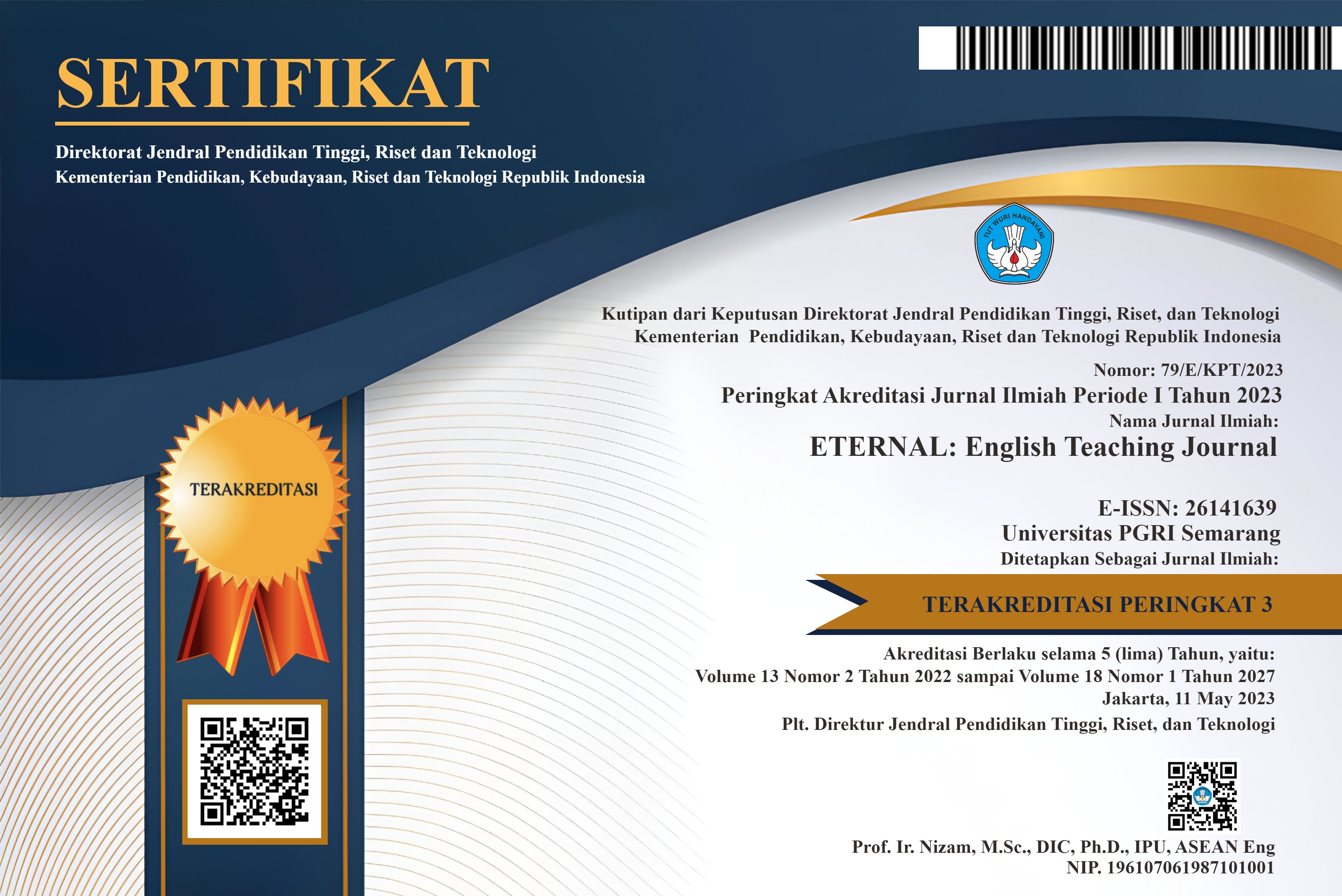Teacher’s Code-Switching in the Teaching-Learning Process in 10th Grade of ESL Class
DOI:
https://doi.org/10.26877/eternal.v15i2.638Keywords:
code-switching, ESL class, students' perception, teacher code-switchingAbstract
Studying CS in ESL classrooms is significant as it can enhance understanding and facilitate communication between teachers and students. This study aims to analyze the types, functions, and students’ perception of code-switching (hereafter, CS) used by an English teacher at a private school in Pekanbaru, Riau to seek whether it is important to use CS in learning process for ESL students. The subjects of this study were an English teacher of ESL classes and 72 ESL students in the academic year of 2023/2024. This research employs a mixed-method approach with a qualitative descriptive design combined with the use of a questionnaire, which is suitable for capturing both the depth and breadth of the phenomenon. To identify the types and functions of CS, the researcher recorded the teacher’s utterances and distributed the questionnaire to get the students’ perception. The data were analyzed using Poplack’s (1980) three types of CS and Cahyani et al.’s (2016) four functions of CS. The results showed that the teacher’s most frequently used type of CS is intra-sentential CS. Additionally, the teacher employed CS to ensure students understand the instructions given. The students showed a positive perception of the teacher’s CS since it helped them understand and comprehend the classroom activities. These results highlight the importance of strategic CS in enhancing student comprehension and participation in ESL classrooms, suggesting broader implications for teaching practices in multilingual settings.
References
Cahyani, H., De Courcy, M., & Barnett, J. (2016). Teachers’ code-switching in bilingual classrooms: exploring pedagogical and sociocultural functions. International Journal of Bilingual Education and Bilingualism, 21(4), 465–479. https://doi.org/10.1080/13670050.2016.1189509
Chaer, Abdul dan Leonie Agustina. 2010. Sosiolinguistik Perkenalan Awal. Jakarta: Rineka Cipta.
Dewi, G. P., Nitiasih, P. K., Artini, L. P., Suwastini, N. K., & Haryanti, N. D. (2021). Investigating the Advantages of Bilingualism: Multidimensional Research Findings. Eternal, 423-441.
Ebsworth, M. E., Ebsworth, T. J., & Cai, C. (2018). English acquisition in Puerto Rico: Teachers’ insights. Bilingual Research Journal, 41(1), 69–88. https://doi.org/10.1080/15235882.2017.1413441
ELCSchool. (2013, September 30). Retrieved from Why is Learning English is so Important?: https://www.elc-schools.com/blog/4-reasons-why-learning- english-is-so-important/
Fishman, J. A. (1972). Sociolinguistic: A Brief Introduction. Rowley: Massachusetts: Newbury House Publisher.
Gerungan, F. N., Olii, S. T., & Andries, F. (2021). AN ANALYSIS OF CODE SWITCHING USED IN CLASSROOM. JELLT (Journal of English Language and Literature Teaching), 5(1). https://doi.org/10.36412/jellt.v5i1.2431
Heugh, K. (2015). Multilingualism, translanguaging, and transknowledging: Translation technology in EMI higher education.
Holmes, J. (2013). An Introduction to Sociolinguistic Fourth Edition. Routledge.
Izzak, A. (2009). Bilingualisme dalam Perspektif Pengembangan Bahasa Indonesia: Mabasan, 15-29.
Jamieson, S. (2004). Likert scales: how to (ab)use them. Medical Education, 38(12), 1217–1218. https://doi.org/10.1111/j.1365-2929.2004.02012.x
Lambert, V. A., & Lambert, C. E. (2012). Qualitative descriptive research: An acceptable design. Pacific Rim International Journal of Nursing Research, 16(4), 255-256.
Muysken, P. (2020). The Cambridge Handbook of Linguistic Code-switching. Cambridge University Press.
Nurhamidah, N., Fauziati, E., & Supriyadi, S. (2018). CODE-SWITCHING IN EFL CLASSROOM: IS IT GOOD OR BAD? JEE (Journal of English Education), 3(2), 78–88. https://doi.org/10.31327/jee.v3i2.861
Nurrohmah, H. An Analysis Of Code Switching Used By English Teacher In The Classroom At The Eighth Grade At Smp Muhammadiyah 4 Surakarta In The Academic Year Of - IAIN Surakarta Repository. (n.d.). https://eprints.iain-surakarta.ac.id/75/
Poplack, S. (1980). Sometimes I’ll start a sentence in Spanish y termino en español. Linguistics, 18, 581–618.
Pfaff, C. W. (1979). Constraints on language mixing: intrasentential Code-Switching and borrowing in Spanish/English. Language, 55(2), 291. https://doi.org/10.2307/412586
Raes, C., & Togi, D. (2020). An Analysis of Code Switching Used by Reza Arap on Deddy Corbuzier’s YouTube Channel. JETAFL L (Journal of English Teaching as a Foreign Language), 30-47.
Romaine, S. (1989). Bilingualism. Oxford; Basil Blackwell.
Romaine, Suzane. 1995. Language in Society: An Introduction to Sociolinguistics. Oxford: Oxford University Press.
Sebba, M., Mahootian, S., & Jonsson, C. (Eds.). (2012). Language Mixing and Code-Switching in Writing: Approaches to Mixed-Language Written Discourse (1st ed.). London: Routledge.
Stockwell, P. (2002). Sociolinguistics - A Resource Book for students by Peter Stockwell. Southern African Linguistics and Applied Language Studies, 21(3), 187–188. https://doi.org/10.2989/16073610309486341
Syarifuddin, S. (2016, October 24). Language Endangerment in Multilingual Indonesia. Retrieved from The Jakarta Post: https://www.thejakartapost.com/youth/2016/10/24/language- endangerment-in-multilingual-indonesia.html
Tolentino, J. (2015, March 12). How I Built This: The Unexpected Paths to Success from the World’s Most Inspiring Entrepreneurs. Houghton Mifflin Harcourt.
Waris, A. M. (2012). Code switching and mixing (Communication in Learning Language). Jurnal Dakwah Tabligh, 13(1), 123-135.
Wardaugh, R. (1986). An Introduction to Sociolinguistic. New York: Blackwell.
Wardaugh, R. (2006). An Introduction to Sociolinguistics. USA: Blackwell Publishing.
Yletyinen H, 2004. The Functions of Codeswitching in EFL Classroom Discourse. Unpublished dissertation. University of Jyväskylä, 2004.







